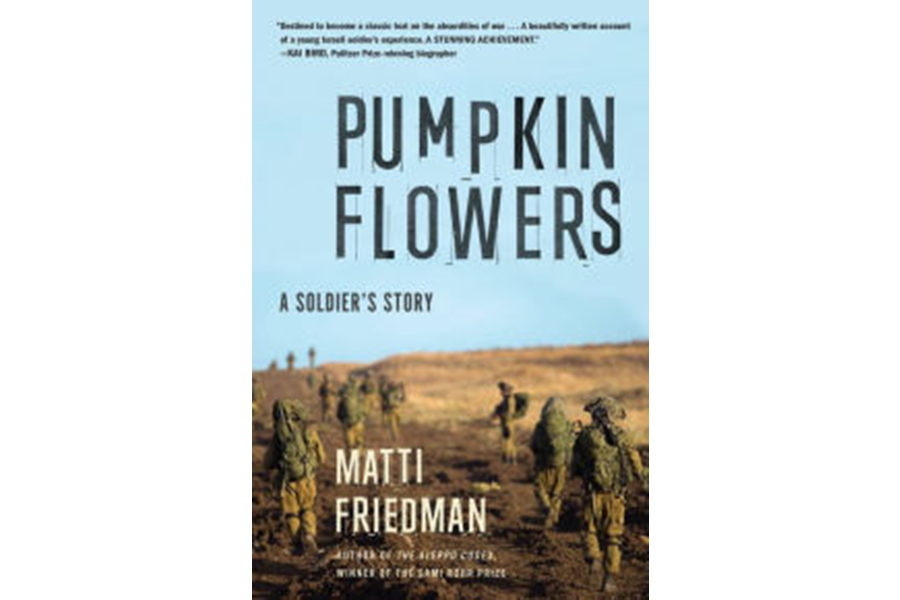'Pumpkinflowers,' a memoir by an Israeli soldier, questions the battle
Loading...
Matti Friedman, author of Pumpkinflowers: A Soldier’s Story, was there at the beginning, in 1998, fighting for Israel in the non-war against the non-state fighters of Hezbollah in ungoverned south Lebanon.
It was, in his telling, the beginning of much of what is happening in the Middle East (and beyond) today: unending conflict with no clear winners or losers, in intractable places where propaganda is more important than victory – indeed, war without end, in which one side views both the suicide and combat deaths of its own fighters as victories.
The skirmishes Friedman describes, some of which he participated in as an Israeli soldier, were not epic. No territory changed hands and nobody admitted defeat. Casualties, while often horrific, were not overly great. And no one bothered to pen a history of this particular Israeli incursion into Lebanon, which ended in 2000, until this personal and moving narrative.
Friedman, a journalist and author of “The Aleppo Codex,” writes with great feeling and insight about the teenagers who died, were maimed, or were changed in profound ways while defending a patch of earth that the Israelis dubbed “Pumpkin.” This hilltop redoubt, six miles inside Lebanon, was the size of a basketball court. It was manned by “flowers” (soldiers), some of whom became “oleanders” (dead soldiers).
The author’s account of military life transcends the particulars of this tale. He quotes from the diary of a young recruit, Avi Ofner, who writes of himself in the third person: “Because one of the commanders would speak to him [Avi] and interrupt his thoughts, A. [Avi] suddenly understood that what they wanted to do was prevent him from thinking. He understood they were his real enemies!”
But Avi, the philosopher/soldier, was no slacker. He died for his country defending Pumpkin and presumably Israel. But during his tour there, the author, among others, came to question that rationale. Friedman muses, “When they [Hezbollah] wanted to strike Israel they simply fired rockets from deeper in Lebanon, outside the [security] zone…. Were we just protecting ourselves?”
Or worse yet, were the Israeli soldiers at Pumpkin, and similar outposts, actually serving the interests of their enemies? In this perverse twist on modern warfare, the Syrian government was only too happy to have handy targets for its proxies, Hezbollah’s guerrillas, while it watched safely from afar.
In a geopolitical contortion worthy of “Catch 22,” when Israel began to ponder leaving Lebanon, Syria’s foreign minister objected, insisting that to withdraw without his nation’s consent would constitute an act of war.
The most telling drama of the book occurs several years after Israel has, in fact, withdrawn, and the author, now a civilian, decides to visit Lebanon as a tourist, traveling from Toronto on his Canadian passport. It is risky business, but Friedman wants to see the places and people he had only glimpsed from a concrete bunker. He also hopes to revisit the ruins of Pumpkin, which is not exactly a tourist hotspot.
Friedman finds the Lebanese friendly, helpful, and welcoming. But when the subject of Israel crops up, the tone changes. Jews are not simply bad, “They kill little babies,” one man tells Friedman, who notes as well that copies of the “Protocols of the Elders of Zion,” the famously fabricated anti-Semitic screed, are for sale in “the better bookstores of Beirut.” (Americans are considered to be very bad as well, he discovers, but what’s not to love about Canadians?)
Friedman would travel 12,000 miles to arrive a mere 20-minute drive from his parents’ home in northern Israel, in a town that is hit periodically by Hezbollah rockets. He eats at a little roadside Lebanese restaurant: an establishment where he and his fellow soldiers had fantasized they would return one day to share a meal in the peaceful times to come.
Indeed, peace was very much thought possible by many Israelis late in the last century, Friedman writes. But the Lebanese incursion also marked the beginning of the end of such sentimental illusions. It was the dawn, too, of the tactical use of suicide bombers and ever more lethal IEDs, the roadside bombs that would soon be so much in evidence in Afghanistan, Iraq, and elsewhere.
Among the places that the author visits in Lebanon are the ruins of a UN compound, which had become a shrine. In 1998 Hezbollah fighters had set up a battery nearby and were firing at Israeli forces, who responded in kind and hit the UN building instead, killing more than 100 civilians taking refuge there.
In describing the ruins of Pumpkin, the author writes, “Atop the western embankment a Hezbollah flag flew at last, but it was just a ragged scrap of fabric that had once been yellow. For a time this hill was worth our lives, but even the enemy seemed to know that now it was worth nothing at all.”






